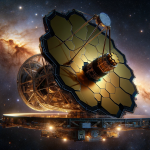High above the Earth, a NASA astronaut provided a unique perspective on Hurricane Beryl as it churned through the Caribbean. Matthew Dominick, a crew member aboard the International Space Station (ISS), captured a striking image of the Category 4 hurricane on July 1, 2024. This image, later shared on his X account, offers a compelling view of the storm’s immense power and the intricate patterns of its swirling clouds.
Understanding Hurricane Formation
Hurricanes, classified as tropical cyclones, draw their energy from warm, moist air over oceans. As air near the ocean surface heats up and rises, it leaves behind a region of lower pressure. Higher pressure air from surrounding areas rushes in to fill this void, also warming and rising, creating a continuous cycle. This process forms the characteristic swirling system of clouds and winds, which intensifies as it feeds off the ocean’s heat and evaporating water.
NASA’s Role in Hurricane Research
NASA leverages its vantage point from space to study and monitor hurricanes. Photographs like the one taken by Dominick, along with data from satellites, provide invaluable insights into the behavior and development of these powerful storms. This research is crucial for understanding the impact of climate change on hurricane patterns and intensity. By analyzing these observations, scientists aim to improve prediction models and enhance community preparedness for future tropical cyclones.
Connecting Climate Change and Hurricanes
The relationship between climate change and hurricanes is a focal point of NASA’s research. As global temperatures rise, the frequency and severity of hurricanes are expected to increase. The data collected from space not only helps in tracking current storms but also in studying long-term trends. This understanding supports the development of strategies for disaster response and mitigation, ensuring that communities are better equipped to handle the challenges posed by a warming world.
In the past, hurricane monitoring relied heavily on ground-based observations and aircraft missions, which provided limited coverage and data. The advent of satellite technology has revolutionized our ability to monitor these storms continuously and from a global perspective. Historical data shows that satellite imagery has significantly improved the accuracy of hurricane forecasts, leading to more timely and effective warnings. This technological shift underscores the importance of space-based observations in enhancing our understanding of extreme weather events.
Moreover, the integration of various data sources, including satellite imagery, ground sensors, and computational models, has enhanced the precision of hurricane predictions. This comprehensive approach allows scientists to create more detailed and accurate forecasts, reducing the uncertainty associated with storm tracking. The improvements in predictive modeling underscore the critical role that advanced technology plays in safeguarding lives and property during hurricane seasons.
The continuous advancements in satellite technology and climate research are pivotal in our ongoing efforts to comprehend and mitigate the impacts of hurricanes. The data collected by NASA and other space agencies not only contribute to immediate disaster response but also to long-term resilience planning. As climate change continues to influence weather patterns, the insights gained from these studies will be instrumental in shaping policies and strategies aimed at protecting vulnerable communities and infrastructures from the devastating effects of hurricanes.










